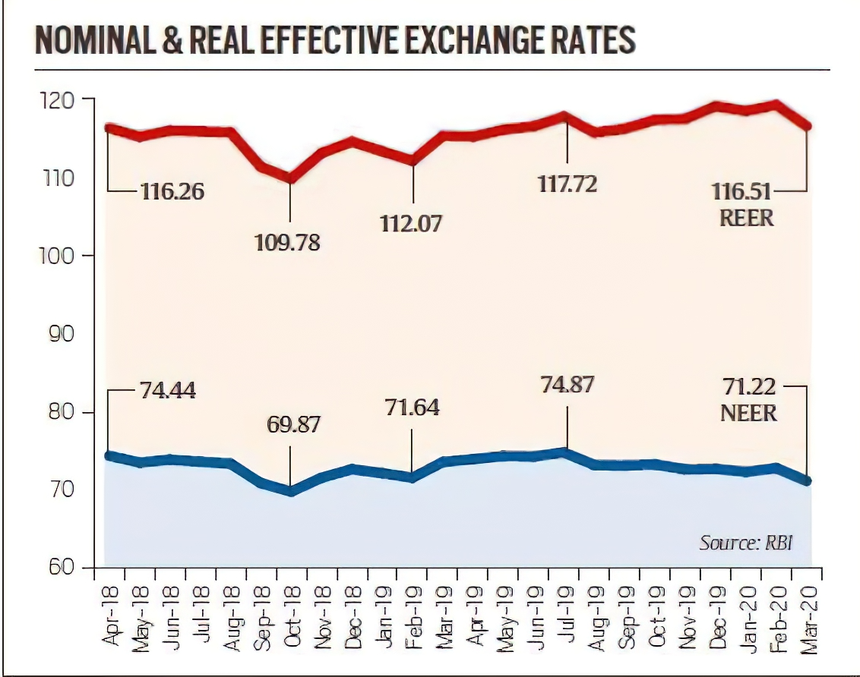NEER Full Form
What is the full form of NEER ?
The nominal effective exchange rate (NEER) is a weighted average exchange rate that represents the nominal value of one country's currency relative to a basket of various foreign currencies. The amount of local currency required to buy foreign currency is known as the nominal exchange rate.
The NEER is a measure of a nation's ability to compete internationally in the foreign exchange (foreign) market. The NEER is also known as the trade-weighted currency index by currency dealers.
The NEER may be modified to account for the difference between the price inflation in the home country and its trading partners. The final number is known as the real effective exchange rate (REER). NEER isn't based on the relationships in a nominal exchange rate individually for each currency. Instead, one specific statistic, usually an index, expresses how the value of one local currency contrasts with several different foreign currencies at once.
- What is the full form of NEER ?
- The nominal effective exchange rate explained
- Importance of NEER
- REER overview
- Comparison between NEER and REER
- The basket of foreign currencies
- The major currencies of the world
- Practicality of the nominal effective exchange rate

In a system with variable exchange rates, NEER is said to appreciate if a domestic currency gains value relative to a basket of other currencies. The NEER depreciates if the local currency declines in value relative to the basket.
The nominal effective exchange rate explained
The nominal effective exchange rate (NEER), which is a concept in economics, is used to assess the strength and profitability of a nation's currency on the global foreign exchange (forex) market. NEER is a broad value that normally appears in an index; it is not expressed as a measure in terms of money. A NEER coefficient above 1.0 indicates that the value of a domestic currency is greater than the value of foreign currencies. A NEER coefficient that is less than 1.0 indicates that the value of the domestic currency is generally lower than that of imported currencies.
The NEER will rise if the value of a nation's currency rises in relation to a basket of other currencies with variable exchange rates. It indicates that, on average, more foreign currency can be bought for each unit of home currency. However, the NEER will decline if a nation's currency loses value in relation to a basket of other currencies. It shows that, on average, less domestic cash can be earned for each unit of foreign currency.
Importance of NEER
In the context of this topic, NEER refers to a process that can represent trade between nations. In this sense, India's NEER is regarded as the weighted box. There is no question that the Indian currency is heavier than the currencies of the other nations with whom India performs more business.
REER overview
The real effective exchange rate (REER), which is represented in inflation differences between the domestic economy and trading partners, is created by adjusting the nominal effective exchange rate (NEER) for relative prices or costs.
Comparison between NEER and REER
REER | NEER |
It displays the domestic currency's adjusted value in relation to other significant trading currencies. | It displays how much the domestic currency is worth in relation to other currencies. |
It takes away the effects of currency-specific inflation differentials just focuses on differences in exchange rates. | Influence coming from the gap in inflation rates between the nation and its trading partners. |
As a result of being corrected for inflation, it is thought to be a more accurate estimate. | It may produce measurements that aren't perfectly precise because of variations in inflation. |
It is determined using the NEER. | It is determined using a currency basket. |
Graph of nominal and real effective exchange rates

Figure 1
According to the graph, the rupee has dropped to its lowest point in NEER terms since November 2018. Since July 2019, the rupee has been steadily depreciating, demonstrating the Indian economy's declining competitiveness.
The rupee declined in March and reached its lowest point since September 2019 in REER terms as well.
The disparity in NEER and REER trends can be attributed to India's domestic retail inflation being lower than that of the other 36 nations. The REER began to depreciate like the NEER when domestic inflation began to rise.
The basket of foreign currencies
Each NEER evaluates a single currency against a group of international currencies. The most significant trading partners and other key currencies of the domestic nation are put into account when choosing this basket. The (United States)U.S. dollar, the Euro, the British pound, the Japanese yen, the Australian dollar, the Swiss franc, and the Canadian dollar are the five most important currencies in the world. A basket of foreign currencies is weighted based on how much trade there is with the home nation. This could be the value of the export or import, the sum of the value of the exports and imports, or any other measure. The weights frequently take into account the financial assets of various nations.
There is no universally accepted method for choosing a currency basket. The International Monetary Fund (IMF), the Federal Reserve, and the Bank of Japan all have different baskets than the Organization for Economic Co-operation and Development (OECD). However, the International Financial Statistics (IFS) produced by the IMF are depended upon by a wide range of institutions.
The major currencies of the world
The following are the major currencies in the world:
U.S. dollar (USD)
British pound (GBP)
Japanese yen (JPY)
Euro (EUR)
Swiss franc (CHF)
Chinese renminbi (CNH)
Canadian dollar (CAD)
Australian dollar (AUD)
New Zealand dollar (NZD)
South African rand (ZAR)
Practicality of the nominal effective exchange rate
The NEER is a relative, abstract value that does not represent the current strength of a currency. Only the strength or weakness of a currency relative to other foreign currencies may be determined using NEER. It basically shows which currencies are more in demand than others, whether this is because of perceived value or a rise in interest in a nation's products or investments. NEER is used by economists to guide decisions about international trade. Furthermore, it is employed by forex traders who deal in foreign exchange for speculative, hedging, or arbitrage reasons.
Aside from the information on newly developing and industrialized countries, the International Monetary Fund (IMF) develops and publishes the nominal and real effective exchange rates for the majority of large, developed countries. The broad effective exchange rates for each country are published by central banks. Economists can learn about trends and changes in the economy and the currency market by looking at the data.
Frequently Asked Questions (FAQs)
Participants from all over the world purchase and sell different currencies on the global currency market. Banks, corporations, central banks, investment management companies, hedge funds, small-time forex brokers, and individuals are among the participants. The importance of the foreign exchange market stems from its contribution to international trade, business purchases, loans, and investments.
REER is greater than NEER because a rise in REER may indicate that imports are becoming less expensive while exports are becoming more exclusive and costly than imports. As a result, it can be said that an increase may signal a decline in trade competitiveness. However, REER is higher than NEER because it is calculated using the multiple of NEER.
The real effective exchange rate (REER), which is represented in inflation differences between the domestic economy and trading partners, is created by adjusting the nominal effective exchange rate (NEER) for relative prices or costs.
To provide medium-term price stability, the NEER varies within a policy band that has been established. For the NEER to remain within the policy band, the Monetary Authority of Singapore (MAS) engages in foreign exchange intervention operations.
The difference in inflation between the domestic currency and that of the trading partners determines the Real Effective Exchange Rate (REER), which is the NEER adjusted accordingly. So, unlike NEER, it provides information on the actual strength of a domestic currency relative to a basket of other currencies.

